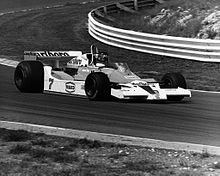Formula One career
Beginnings with Hesketh
Hesketh purchased a March 731 chassis, and it was developed by Harvey Postlethwaite. The team was initially not taken seriously by rivals, who saw the Hesketh team as a party goers enjoying the glamour of Formula One. The Hesketh March proved much more competitive than the works March cars, and their best result was second place at the 1973 United States Grand Prix. For the 1974 season Hesketh Racing built a car, inspired by the March, called the Hesketh 308, but an accompanying V12 engine never materialised. The Hesketh team captured the public imagination as a car without sponsors' markings, a teddy-bear badge and a devil-may-care team ethos, which belied the fact that their engineers were highly competent. Hunt's season highlight was a victory at the BRDC International Trophy non-Championship race at Silverstone, against the majority of the regular F1 field.Hunt's first World Championship win came in the 1975 Dutch Grand Prix at Zandvoort. He finished fourth in the Championship that year, but Lord Hesketh had run out of funds and could not find a sponsor for his team. With little time left before the 1976 season, Hunt was desperately looking for a drive until Emerson Fittipaldi left McLaren and joined his brother's Copersucar-Fittipaldi outfit. With no other top drivers available, the team management signed Hunt to McLaren for the next season – he was one of the cheapest World Champions ever (Keke Rosberg in 1982 similarly found a drive at the last minute). Hunt immediately caused a stir by refusing to sign a clause in his contract which stipulated he wore suits to sponsor functions. Hunt wore t-shirt and jeans and was often barefoot for sponsor-led functions with world leaders, chairmen of businesses and media moguls.
World Championship year
1976 was Hunt's best year. He drove the McLaren M23 to six Grands Prix wins. He was disqualified and later reinstated as the winner of the 1976 Spanish Grand Prix for driving a car adjudged to be 1.8 cm too wide. Victory at the British Grand Prix was disallowed after an accident at the first corner that Hunt was involved in. At the Italian Grand Prix, the Texaco fuel that McLaren used was tested and although apparently legal, the Penske cars, running the same fuel, had a much higher octane level than allowed and subsequently both teams were forced to start from the rear of the grid.Niki Lauda's near-fatal accident in Germany, which caused him to miss the following two races, allowed Hunt to close the gap to the Austrian. As they went to the final round in Japan Hunt was just three points behind. The Japanese Grand Prix was torrentially wet, and Lauda retired early on in the race, unable to blink because of facial burns from his accident in Germany. After leading most of the race Hunt suffered a puncture, then had a delayed pitstop and finally received mixed pit signals from his team. But he managed to finish in third place, scoring four points, enough for him to win the World Championship by one point.
Decline and retirement
The 1977 Formula One season did not start well for Hunt. The McLaren M26 was problematic in the early part of the season, during which Niki Lauda and Mario Andretti took a considerable lead in the Drivers' Championship. Towards the end of the year Hunt and the McLaren M26 were quicker than any rival combination other than Mario Andretti and the Lotus 78, and Hunt won in Watkins Glen and Fuji. He finished fifth in the World Drivers'Championship.In the 1978 season Hunt scored only eight world championship points. Lotus had developed effective ground effect aerodynamics with their Lotus 79 car, and McLaren were slow to respond. The M26 was revised as a ground effect car midway through the season but it did not work, and without a test driver to solve the car's problems, Hunt's motivation was low. His inexperienced new team-mate Patrick Tambay even outqualified Hunt at one race.
James Hunt was greatly affected by Ronnie Peterson's fatal crash in the 1978 Italian Grand Prix. At the start of the race there was a huge accident going into the first corner. Ronnie Peterson's Lotus was pushed into the barriers and burst into flames. Hunt, together with Patrick Depailler and Clay Regazzoni, rescued Peterson from the car, but Peterson died one day later. Hunt took his friend's death particularly hard and for years afterwards blamed Riccardo Patrese for the accident. Video evidence of the crash has since shown that Patrese did not touch Hunt or Peterson's cars, nor did he cause any other car to do so. Hunt believed, however, that it was Patrese's muscling past that caused the McLaren and Lotus to touch, but Patrese argues that he was already well ahead of the pair before the accident took place.
For 1979 Hunt moved to the initially very successful Walter Wolf Racing team for what would be his last, brief, Formula One season. The team's ground effect car was uncompetitive and Hunt soon lost any enthusiasm for racing. His private life was also becoming increasingly turbulent. After failing to finish the 1979 Monaco Grand Prix, the race where six years previously he had made his debut, Hunt made a statement to the press announcing his immediate retirement and walked away from F1 competition



0 comments:
Post a Comment